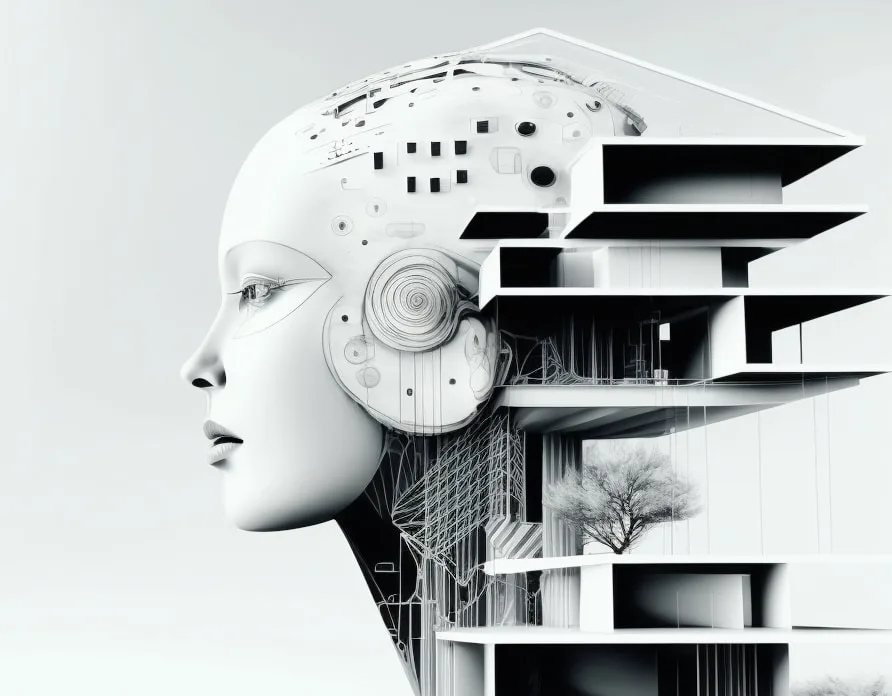Imagine a world where buildings seamlessly adapt to our needs, maximizing efficiency and sustainability through intelligent design. This is the exciting promise of artificial intelligence (AI) in architecture. By harnessing data analytics and AI, architects can push the boundaries of precision and creativity. AI allows architects to focus on their core strengths—envisioning and creating remarkable spaces—by automating repetitive tasks, predicting structural performance, and generating innovative design concepts.
AI is not just a buzzword; it’s a transformative force reshaping architecture. Enhancing project outcomes, reducing costs, and promoting sustainability are just a few of the benefits AI brings to the table, paving the way for smarter, more responsive urban environments.
According to the Royal Institute of British Architects (RIBA) 2024 report, 41% of architects globally are now utilizing AI in their projects. This widespread adoption underscores the significant efficiency gains and innovative possibilities AI introduces to architectural workflows.
In this blog, we’ll dive into the role of AI in architecture, explore its benefits, and discuss its implementation challenges. We’ll also highlight how generative AI is setting new benchmarks in design. Let’s embark on this journey through AI’s transformative impact on architecture.
How AI is Shaping the Future of Architecture
AI in architecture leverages advanced algorithms and data analytics to enhance design, planning, and construction processes. It improves efficiency, creativity, and sustainability in building projects, acting as a digital design assistant that can process vast amounts of data to create optimal and aesthetically pleasing structures.
The integration of AI with augmented reality (AR) and virtual reality (VR) allows architects to experience their designs in immersive environments, enabling precise refinements. Furthermore, AI’s predictive maintenance capabilities help ensure buildings operate sustainably and functionally over their entire lifespan. This powerful fusion of architecture and AI drives innovation and efficiency in the built environment.
According to Precedence Research, the global market for generative AI in design is expected to reach $7.75 billion by 2032, growing at a compound annual growth rate (CAGR) of 34.11% from 2022 to 2032. This rapid growth highlights the increasing demand for AI-driven design solutions that foster innovation and sustainability.
The Key Benefits of AI in Architecture
AI revolutionizes architecture by optimizing design processes and enhancing project management. Here are some key benefits:
1. Innovation: AI empowers architects to explore novel design solutions. By analyzing data and patterns, AI can suggest innovative approaches to complex design challenges, pushing the boundaries of creativity.
2. Enhanced Visualization: AI-powered AR/VR technologies offer immersive visualizations of architectural designs. Clients can experience designs in a realistic context, leading to more informed decision-making and improved project outcomes.
3. Adaptability: AI systems enable buildings to adapt to changing user needs and environmental conditions. Intelligent control systems optimize resource usage and extend the life of the building, promoting sustainability.
4. Historical Insights: AI provides access to extensive historical data, helping architects understand past design trends and make better-informed decisions about contemporary designs.
5. Accessibility: AI-driven tools ensure that designs meet accessibility standards, creating inclusive spaces that cater to diverse user needs and promote equality.
6. Customization: AI enables highly personalized design solutions tailored to specific client needs and site conditions, enhancing both functionality and aesthetic appeal.
7. Efficient Space Utilization: AI optimizes the use of space, providing layout recommendations based on user preferences and traffic patterns to maximize the efficiency of every square foot.
Real-Life Examples of AI in Action
AI’s integration into architecture is already yielding impressive results. Here are some notable examples:
NBBJ: By utilizing Natural Language Processing (NLP), NBBJ streamlines design documentation and internal communication, improving accuracy and productivity through intelligent chatbots.
Gensler: Gensler employs AI for sketching optimization, enhancing creativity and making informed design decisions with AI-driven structural performance forecasts.
SOM: Skidmore, Owings & Merrill (SOM) uses AI to optimize energy management in buildings, making data-driven decisions that reduce costs and environmental impact.
Perkins and Will: AI-driven parametric design tools at Perkins and Will lead to innovative and efficient building designs, balancing visual appeal with structural performance.
Jacobs Engineering: AI technologies from Jacobs Engineering improve architectural mapping, supporting better land use and development strategies.
Quintain: Quintain uses Delve, a machine learning platform, to refine urban planning and create more efficient, livable urban spaces.
AECOM: AECOM integrates Autodesk’s generative design tools to enhance design efficiency, optimize building layouts, and improve structural integrity.
Caterpillar: AI systems from Caterpillar monitor equipment and worker behavior to identify safety risks, enhancing site safety through real-time data analysis.
Implementing AI in Your Architectural Projects
Integrating AI into architectural workflows involves several key steps:

- Data Compilation and Preparation: Gather and clean large-scale datasets to ensure accuracy and consistency. This foundational step is crucial for effective AI implementation.
- Goal Definition: Set clear objectives for AI integration, whether for sustainability, process automation, or design optimization. Involve stakeholders to align AI goals with project requirements.
- Tool and Technology Selection: Choose AI tools and technologies that align with your goals and integrate smoothly with existing workflows. Consider factors like scalability, user-friendliness, and support.
- AI Model Development: Train AI models using your prepared data to identify patterns and generate design solutions. Validate these models in real-world scenarios to ensure their reliability.
- Software Integration: Incorporate AI models into architectural design software such as CAD and BIM to enhance their functionality without disrupting established processes.
- Workflow Optimization: Automate repetitive tasks and optimize resource allocation with AI-powered solutions, boosting creativity and efficiency in your design processes.
- Ongoing Monitoring and Evaluation: Continuously monitor AI models to ensure they meet objectives. Gather feedback from stakeholders to refine and improve AI algorithms.
Overcoming Challenges in AI Integration
Implementing AI in architecture comes with its challenges. Here’s how to address them:
Data Quality: Improve data quality by partnering with data suppliers and establishing robust data governance procedures.
Complexity: Develop adaptable AI models that incorporate user feedback and refine design recommendations based on evolving criteria.
Interoperability: Invest in open-source solutions or API-driven technologies to ensure smooth integration across systems. Establish industry standards for data exchange.
Security and Privacy: Implement strong encryption, limit data access, and follow regulatory guidelines. Regularly update security measures to protect sensitive information.
Ethical Considerations: Ensure transparency in AI decision-making, implement bias detection strategies, and adhere to ethical principles in design.
Partner with TechDotBit to Embrace AI in Architecture
The future of architecture is here, and AI is leading the way. From enhancing design processes to optimizing building performance, AI empowers architects to achieve greater creativity, efficiency, and sustainability.
At TechDotBit, we’re ready to be your partner in harnessing AI for architectural excellence. With our expertise in AI development and a deep understanding of the architectural industry, we can help you integrate AI technologies that elevate your projects.
From concept to completion, TechDotBit offers support in leveraging AI to enhance creativity, efficiency, and sustainability. Connect with us to unlock the full potential of AI in architecture and shape the future of architectural design.
FAQs
Q: How is AI used in architecture?
A: AI automates tasks, enhances design processes, and predicts building performance, helping architects create innovative layouts and optimize energy savings.
Q: What is the future of AI in architecture?
A: The future of AI in architecture includes advancements in generative design, automation of routine tasks, improved performance prediction, and enhanced sustainability.
Q: What is generative AI in architecture?
A: Generative AI autonomously generates design solutions based on specific goals and constraints, exploring a range of options to provide creative and efficient design outcomes.
Q: How does AI impact the role of architects?
A: AI streamlines workflows, allowing architects to focus on creative aspects by automating repetitive tasks and optimizing design decisions, leading to more innovative and efficient projects.
Partner with TechDotBit to integrate AI into your architectural workflows and lead the charge in innovative, sustainable design. Contact us today.








